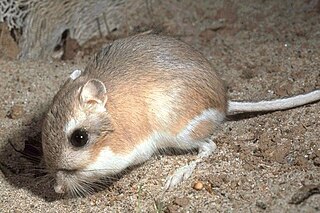
Heteromyidae is a family of rodents consisting of kangaroo rats, kangaroo mice, pocket mice and spiny pocket mice. Most heteromyids live in complex burrows within the deserts and grasslands of western North America, though species within the genus Heteromys are also found in forests and their range extends down as far as northern South America. They feed mostly on seeds and other plant parts, which they carry in their fur-lined cheek pouches to their burrows.

Dipodomyinae is a subfamily of heteromyid rodents, the kangaroo rats and mice. Dipodomyines, as implied by both their common and scientific names, are bipedal; they also jump exceptionally well. Kangaroo rats and mice are native to desert and semidesert ecosystems of western North America from southern Canada to central Mexico. They are generally herbivorous foragers, and dig and live in burrows.

Perognathinae is a subfamily of rodents consisting of two genera of pocket mice. Most species live in complex burrows within the deserts and grasslands of western North America, They feed mostly on seeds and other plant parts, which they carry in their fur-lined cheek pouches to their burrows.

The Zacatecan deer mouse or southern rock mouse is a species of rodent in the family Cricetidae. It is found only in Mexico, and is not considered endangered.
Winkelmann's mouse is a species of rodent in the family Cricetidae found only in Mexico, and is named for John R. Winkelmann, who collected the first specimens.

The spiny pocket mouse is a species of rodent in the family Heteromyidae and order Rodentia. It is found in Baja California in Mexico and in Arizona, California and Nevada.

Heteromys is a genus of rodents in the family Heteromyidae, commonly known as spiny pocket mice. It is the only extant genus in the subfamily Heteromyinae which also includes the extinct genera Diprionomys and Metaliomys. Heteromys was recently enlarged by inclusion of the members of formerly recognized heteromyine genus Liomys, which was found to be paraphyletic.
Goldman's spiny pocket mouse is a species of rodent in the family Heteromyidae. It has been reported to be a subspecies of Heteromys desmarestianus. It is found in Guatemala and Mexico. Its natural habitat is subtropical or tropical moist lowland forests.

Nelson's spiny pocket mouse is a species of rodent in the family Heteromyidae. It is found in Mexico and Guatemala. Its natural habitat is subtropical or tropical moist lowland forests. It is threatened by habitat loss.

The Panamanian spiny pocket mouse, also known as Peter's spiny pocket mouse, is a species of heteromyid rodent endemic to Panama. It is very closely related to Salvin's spiny pocket mouse, and has been placed in the same species group by some authors. It was formerly placed in the genus Liomys, which is now recognized to be paraphyletic and has been subsumed into Heteromys.

The Mexican spiny pocket mouse is a species of rodent in the family Heteromyidae. It is native to Mexico and Texas in the United States where it is found in dry, scrubby habitats. The IUCN has assessed it as being of "least concern". It was formerly placed in the genus Liomys, which is now recognized to be paraphyletic and has been subsumed into Heteromys.
The painted spiny pocket mouse is a species of rodent in the family Heteromyidae. It is found in Mexico and the northern tip of Guatemala. It was formerly placed in the genus Liomys, which is now recognized to be paraphyletic and has been subsumed into Heteromys.

Salvin's spiny pocket mouse is a small to medium-sized rodent in the family Heteromyidae. It was formerly placed in the genus Liomys, which is now recognized to be paraphyletic and has been subsumed into Heteromys.

The pale kangaroo mouse or Soda Spring Valley kangaroo mouse is a species of rodent in the family Heteromyidae. It is endemic to California and Nevada in the United States.

Merriam's pocket gopher is a species of rodent in the family Geomyidae. It is endemic to Mexico, where it is found in the area of the Valley of Mexico and the Valley of Toluca at elevations from 1800 to 4000 m. Its favored habitats are the Zacatonal grassland and temperate pine-oak woodlands, as well as farmland and rangeland. Its karyotype has 2n = 36 and FN = 68.

The Chihuahuan pocket mouse is a species of heteromyid rodent found in the southwestern United States and Mexico. It was formerly considered a subspecies of the desert pocket mouse, but was determined to be a distinct species in 1996, following analysis of its mitochondrial DNA.
L. spectabilis may refer to:

Heteromyinae is a subfamily of rodents in the family Heteromyidae, commonly known as spiny pocket mice. It contains a single extant genus, Heteromys, as well as the extinct genera Diprionomys and Metaliomys. Heteromys was recently enlarged by inclusion of the members of formerly recognized heteromyine genus Liomys, which was found to be paraphyletic.
The Perote pocket gopher, or Cofre de Perote pocket gopher, is a species of pocket gopher in the family Geomyidae.
The overlook spiny pocket mouse is a species of heteromyid rodent endemic to Venezuela.













